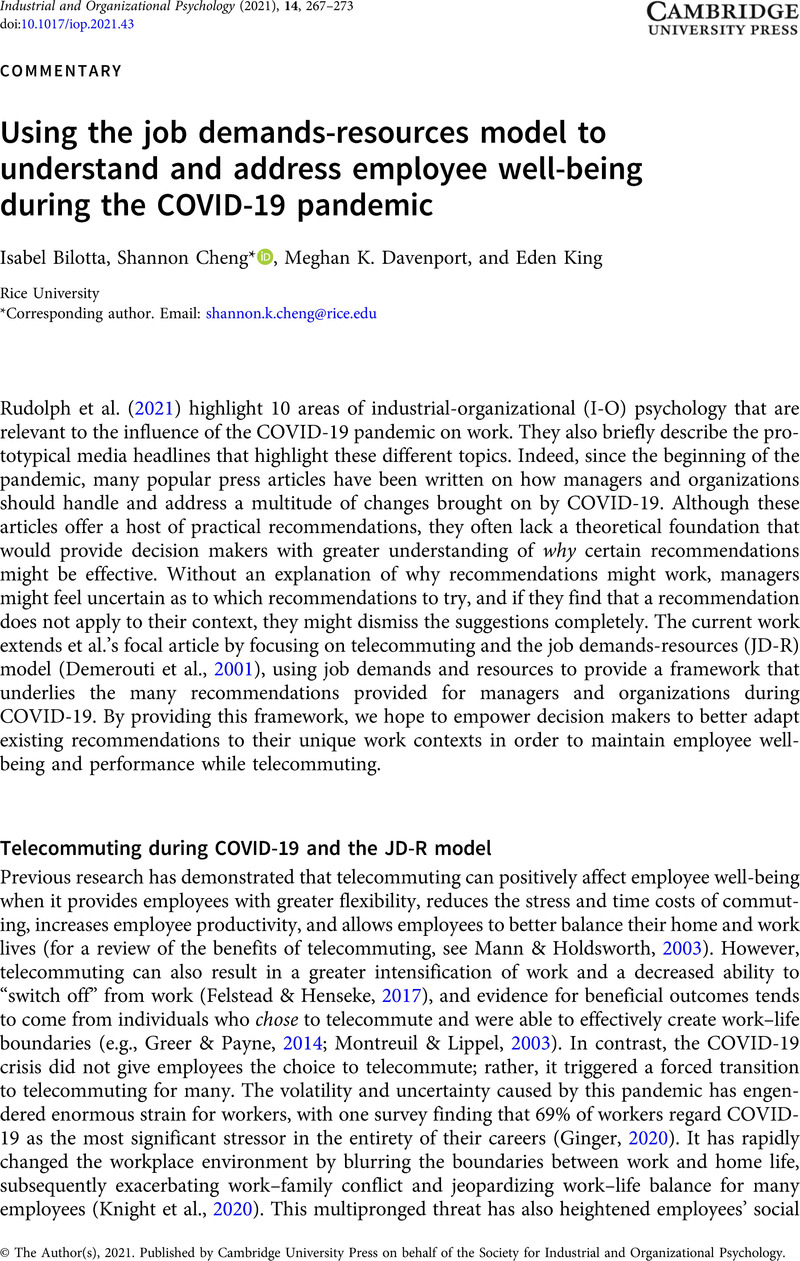Crossref Citations
This article has been cited by the following publications. This list is generated based on data provided by Crossref.
Şimşek Demirbağ, Kübra
and
Demirbağ, Orkun
2022.
Who said there is no place like home? Extending the link between quantitative job demands and life satisfaction: a moderated mediation model.
Personnel Review,
Vol. 51,
Issue. 8,
p.
1922.
Günther, Niklas
Hauff, Sven
and
Gubernator, Philip
2022.
The joint role of HRM and leadership for teleworker well-being: An analysis during the COVID-19 pandemic.
German Journal of Human Resource Management: Zeitschrift für Personalforschung,
Vol. 36,
Issue. 3,
p.
353.
Jeske, Debora
2022.
Remote workers' experiences with electronic monitoring during Covid-19: implications and recommendations.
International Journal of Workplace Health Management,
Vol. 15,
Issue. 3,
p.
393.
Tapani, Annukka
Sinkkonen, Merja
Sjöblom, Kirsi
Vangrieken, Katrien
and
Mäkikangas, Anne
2022.
Experiences of Relatedness during Enforced Remote Work among Employees in Higher Education.
Challenges,
Vol. 13,
Issue. 2,
p.
55.
Andersone, Nelda
Nardelli, Giulia
Ipsen, Christine
and
Edwards, Kasper
2022.
Exploring Managerial Job Demands and Resources in Transition to Distance Management: A Qualitative Danish Case Study.
International Journal of Environmental Research and Public Health,
Vol. 20,
Issue. 1,
p.
69.
Samroodh, Mohammed
Anwar, Imran
Ahmad, Alam
Akhtar, Samreen
Bino, Ermal
and
Ali, Mohammed Ashraf
2022.
The Indirect Effect of Job Resources on Employees’ Intention to Stay: A Serial Mediation Model with Psychological Capital and Work–Life Balance as the Mediators.
Sustainability,
Vol. 15,
Issue. 1,
p.
551.
Jeske, Debora
and
Calvard, Thomas Stephen
2022.
Handbook of Research on Challenges for Human Resource Management in the COVID-19 Era.
p.
403.
Rurkkhum, Suthinee
2023.
A bundle of human resource practices and employee resilience: the role of employee well-being.
Asia-Pacific Journal of Business Administration,
Demerouti, Evangelia
and
Bakker, Arnold B.
2023.
Job demands-resources theory in times of crises: New propositions.
Organizational Psychology Review,
Vol. 13,
Issue. 3,
p.
209.
Lenz, Lena
Hattke, Fabian
Kalucza, Janne
and
Redlbacher, Friederike
2023.
Virtual Work as a Job Demand? Work Behaviors of Public Servants during Covid-19.
Public Performance & Management Review,
Vol. 46,
Issue. 6,
p.
1382.
AlZgool, Mahmoud
AlMaamari, Qais
Mozammel, Soleman
Ali, Hyder
and
Imroz, Sohel M.
2023.
Abusive Supervision and Individual, Organizational Citizenship Behaviour: Exploring the Mediating Effect of Employee Well-Being in the Hospitality Sector.
Sustainability,
Vol. 15,
Issue. 4,
p.
2903.
Park, Ju Won
Park, Seejeen
and
Cho, Yoon Jik
2023.
More isn’t always better: exploring the curvilinear effects of telework.
International Public Management Journal,
Vol. 26,
Issue. 5,
p.
744.
Li, Gang
Zheng, Qiqi
and
Xia, Mengyao
2023.
How do human resource practices help employees alleviate stress in enforced remote work during lockdown?.
International Journal of Manpower,
Vol. 44,
Issue. 2,
p.
354.
Kwia, Josiah
2023.
Organizational Behavior.
p.
1.
Wang, Qifan
Khan, Sajjad Nawaz
Sajjad, Muhammad
Sarki, Irshad Hussain
and
Yaseen, Muhammad Noman
2023.
Mediating Role of Entrepreneurial Work-Related Strains and Work Engagement among Job Demand–Resource Model and Success.
Sustainability,
Vol. 15,
Issue. 5,
p.
4454.
AL, Begüm
2023.
Culture, Motivation, and Performance: Remote and Workplace Dynamics in Organizations.
OPUS Journal of Society Research,
Gutworth, Melissa B.
Howard, Matt C.
and
Simonet, Daniel V.
2023.
Mandated but willing? Preferences and expectations among mandatory work from home employees.
Human Resource Management Journal,
Chowhan, James
and
Pike, Kelly
2023.
Workload, work–life interface, stress, job satisfaction and job performance: a job demand–resource model study during COVID-19.
International Journal of Manpower,
Vol. 44,
Issue. 4,
p.
653.
Smollan, Roy K.
Morrison, Rachel L.
and
Cooper-Thomas, Helena D.
2023.
Working from home during lockdown: the impact on performance and wellbeing.
Journal of Management & Organization,
p.
1.
Majeed, Fatima
and
Ul haq, Junaid
2023.
Healthy employees are assets: a structural model based on individual and organizational characteristics for hotel employee well-being.
Evidence-based HRM: a Global Forum for Empirical Scholarship,





